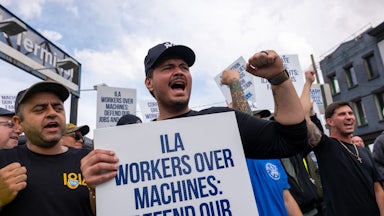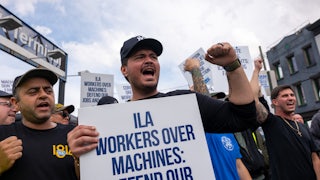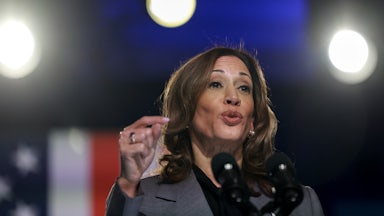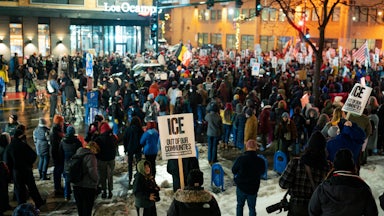Donald Trump polls better with people who don’t vote (especially men) than with people who do. A New York Times/Siena poll of registered voters conducted September 3–6 showed Trump leading Kamala Harris narrowly, 48–46 percent. But the same poll showed that among those who didn’t vote in 2020, Trump led decisively, 48–41 percent. In a Times/Siena poll of registered voters conducted September 21–26 in the battleground state of Michigan, Harris led Trump narrowly, 48–47 percent. But among those who didn’t vote in 2020, Trump crushed Harris, 50–40.
Elections are won by securing support from those who vote, not those who don’t. But the 2024 race is so tight that the Trump campaign is vigorously courting so-called “low-propensity” voters. “We know they agree with us,” the Trump campaign’s political director, James Blair, told Reuters. “We know they favor us, but we have to get them to the polls.” According to Reuters, Elon Musk’s America PAC and Charlie Kirk’s Turning Point Action are both targeting people who don’t vote, in the hope that this year they will.
Who is this low-propensity voter? According to a poll conducted September 13–23 in Michigan by Data for Progress, a progressive think tank and polling firm (top lines here; crosstabs here), the infrequent voter is more likely than not white (51 percent) and employed either full-time (51 percent) or part-time (9 percent). If our low-propensity voter isn’t working, that’s probably because he’s retired (14 percent) or a student (10 percent). He is most likely a political independent (56 percent). Not voting in 2020 situates him among roughly one-third of eligible voters who failed to do so, even though turnout was higher in 2020 than in any election since 1900, according to the Pew Research Center. Turnout could well be higher in 2024. That’s why the Trump campaign is stalking this group.
A word about voter turnout. Since the start of this century, Republicans have, through various disenfranchisement schemes, devoted themselves to reducing it. These efforts have enjoyed some success in the South, but nationally they’ve mostly been self-defeating. In fact, the GOP has so thoroughly pissed off the targeted groups (mainly African Americans and college students) that turnout for these cohorts has mostly increased. All good small-d democrats favor high voter participation, and I do too. But it isn’t necessarily a sign that our republic is in good health. You may have noticed that ours is not exactly an Era of Good Feelings, and historically, I’m sorry to report, high voter turnout tends to coincide with Eras of Bad Feelings.
In the United States, turnout among eligible voters, who did not yet include women or, practically speaking, African Americans, reached its all-time high between 1840 and 1900 (70–80 percent; sometimes higher). That epoch, you’ll recall from high school history class, encompassed the divisive period leading up to the Civil War; the Civil War itself; and the war’s dismal aftermath: four decades characterized by three presidential assassinations, the craven abandonment of Reconstruction, the rise of economic trusts, the broad acceptance of eugenics and social Darwinism, the violent suppression of unions, and a level of political corruption that would make Robert Menendez blush. If you think things are bad today, they were worse then.
Republicans have expanded voter participation not only by trying to limit it but also by turning their party into a MAGA cult that promotes violent insurrection, nativism, racism, and authoritarianism. The cult draws a lot of bottom-feeders to the polls, while simultaneously repelling so many others that come Election Day they set the alarm clock one hour early and sleep with their running shoes on. Now the GOP is experimenting with this new idea of increasing turnout more deliberately, by courting nonvoters. But according to the Data for Progress poll in Michigan, and a second poll of low-propensity voters in Georgia (top lines here; crosstabs here), this group ought to be receptive to the same sort of messaging I’ve been urging Democrats to step up—especially with working-class voters. Low-participation voters are not as conservative as they think they are. United for Respect, the nonprofit (founded by the United Farm and Commercial Workers) that sponsored the Data for Progress survey, is banking on that assumption as it works to mobilize infrequent voters in swing states.
First, the bad news. Infrequent voters don’t care very much about health care. In Michigan, only 4 percent said it was their top priority; in Georgia, only 3 percent did. Even the Democrats among them were indifferent, with 6 percent making it their top priority in Michigan and 5 percent in Georgia. I have argued, strenuously, that health care is the paramount economic issue, and that Democrats should exploit their huge advantage on this topic over Republicans. But to whatever extent Democrats are doing so, it isn’t getting across.
With that out of the way, let’s consider the good news.
For starters, these voters don’t care very much about Trump’s (and the GOP’s) two biggest issues, “taxes and government spending.” In both Michigan and Georgia, only 3 percent chose these as their top priority. (Sorry, Ludwig von Mises!) Even among Republicans, only 5 percent in Michigan and 4 percent in Georgia ranked these highest.
What does this election-avoiding creature care about most? “Economy, cost of living, and inflation,” according to the survey. Thirty-seven percent ranked it highest in Michigan, and 43 percent ranked it highest in Georgia. Because of the description’s emphasis on inflation (did Data for Progress really have to say both “cost of living” and “inflation”?), these responses cut against Harris. But in second and third place we find “abortion” (9 percent in both states) and “threats to democracy” (8 percent in Michigan, 6 percent in Georgia). These cut much more heavily against Trump.
Low-propensity voters are pretty fed up with the government’s coddling of corporations and the rich. An overwhelming majority—75 percent in Michigan, 81 percent in Georgia—agreed that “the government generally favors wealthy individuals and corporations over working and middle-class Americans” Even most Republicans agreed with this (Michigan: 58 percent; Georgia: 74 percent). An overwhelming majority also agreed that “the government should be doing more” to regulate corporations (Michigan: 62 percent, including 46 percent of Republicans; Georgia: 63 percent, including 43 percent of Republicans). Given these responses, low-propensity voters should be receptive to Democratic messaging about Trump’s appalling giveaways to the rich and contempt for the administrative state.
And yes, these voters like labor unions! Sixty-seven percent in both Michigan and Georgia either “strongly” or “somewhat” support “making it easier for workers to form unions and collectively bargain with employers while protecting them from retaliation at work.” Even among Republicans, fully 49 percent in both states said the same. I’ve looked high and low for the voter who would object were Harris to more forthrightly embrace organized labor. I have yet to find him—because the taboo dwells not with voters but with donors. (In fairness, she did very well Wednesday when she said striking dockworkers “deserve a fair share” of the maritime industry’s record profits and took the opportunity to attack Trump’s dismal labor record.)
The 2024 election will more likely be decided by people who showed up in 2020 than by people who didn’t. But all signs indicate this contest will be close, and any success that Trump has in adding to his coalition could be decisive. Harris should at least match Trump’s efforts to win support from low-propensity voters. Many of them seem at least to think that this year they really will remember to show up on Election Day. The majority told Data for Progress that they are “more enthusiastic” than usual: 57 percent in Michigan, 56 percent in Georgia. And in both places, significantly higher proportions of Democrats than Republicans were “more enthusiastic” (with a spread of 14 points in Michigan and nine points in Georgia).
That makes sense. If I were a Republican, I’d feel less motivated to vote this year, because the GOP is a hot mess. The Democrats can’t afford to ignore nonvoters, because if these folks do get it together and vote, their plan right now is to vote for Trump. It’s well worth trying to persuade them that Harris is the better candidate, because she is, damn it—especially for them.








